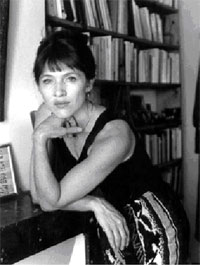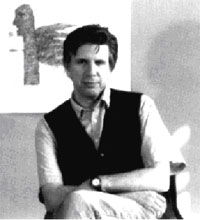Nancy Huston's trajectory from Calgary to New Hampshire to Paris forms part of her "musings on land, tongue, and self." She begins with T.S. Eliot ("Home is where you start from"), Gerard Manley Hopkins ( "not live this tormented mind / With this tormenting mind tormenting yet"), and Sviatoslov Richter ("I do not like myself. Yes."). All of which add up to self-hatred, Huston's point of departure. Inspired by Roland Barthes's Mythologies, Losing North owes its sensitivity to language and stylistics to Barthes's penchant for parentheses, colons, semi-colons, ellipses, and long sentences. Huston herself charts a middle course between Barthes's "zero degree" writing and mannered prose. As well, she structures her chapters in the mode of French structuralism: "Orientation" and "Disorientation", "Nature and Nurture and Nature", and "Relatively Relative."

Wislawa Szymborska
Although Huston classifies herself as a practitioner of "false bilingualism" (one who comes late to the second language), her writing habits indicate that she is truly bilingual. After reminding us that "disorientation" means to lose the east, she shifts her global compass to "losing north", which in French means to lose track of what's happening. Loss of direction, home, childhood, and language form the major themes of Huston's ruminations; the needle of her compass veers from the True North Strong and Free to Parisian liberty, equality, and cosmopolitanism. "People in exile are rich¨rich with the accumulated sum of their contradictory identities." At times, her apertus are so true that they risk becoming platitudes.
On the one hand, exile provides a richness of experience; on the other hand, there is an abject side to disorientation where "the two worlds are not only dissimilar but hostile and hierarchized" The adult who voluntarily leaves her native land for another language and culture has to adopt a mask in the new realm of theatre, and adapt to a new identity. In the early 1970s Huston abandoned English and her piano for French and the harpsichord.
Huston's musing on her split self is filled with literary allusions, particularly to Milan Kundera. Her identity is further fragmented in her three marriages: in a chapter entitled "The Three Daughters-in-Law", she describes her three very different mothers-in-law. The first, a Jewish woman from the Bronx; the second, a retired socialist schoolteacher from central France; and the third, a self-effacing librarian from Sofia, Bulgaria. The sociology beneath this domestic globalism has a fairy-tale quality about it. Huston ends her slim volume by imagining her other selves, and concludes: "Who can accept the idea of having only one life?" If Huston loses north, she finds and gains other directions that enrich her own life and the lives of her readers.

HermTnTgilde Chiasson
Huston's expatriate life in France offers a unique perspective on her Canadian past; similarly, the Acadian writer, HermTnTgilde Chiasson, offers another unique perspective in Available Light. Just as Losing North is a translation of Nord perdu, so Available Light is Wayne Grady's fine translation of Brunante (dusk or twilight in Acadian). Indeed, there is a twilight quality about Chiasson's thirty-four essays, reflections, and meditations that are more poetic than Huston's. Like Huston again, Chiasson has been influenced by Kundera. His essay, "The Unbearable Lightness", begins with a soccer player on French television, remembering reading The Unbearable Lightness of Being. Chiasson undertakes to read all of Kundera's work, which focuses on the writing itself, with the subject as pretext¨a modernist strategy Chiasson himself employs. Citing such artists as Duane Michaels, Kundera, Pina Bausch, Antoni TapiFs, and Martin Scorcese, Chiasson aspires to this company of creators with his multi-faceted talents.
Chiasson abruptly shifts to the inadequate film version of Kundera's novel, which fails because cinema cannot capture some of the internal intricacies of fiction. Chiasson's descriptions of Kundera's style apply equally to his own writing: no sooner does he comment on Kundera's complex and breathtaking ellipses than he shifts to the work of Robert Rauschenberg¨"tonality instead of colour, the whole balanced in a delicate montage, an erudite equilibrium of the intuited and the known." Chiasson's tonal montage then switches to the Acadian writer France Daigle, who reminds him of Kundera because of her silences and slowness. With its modernist ruptures, Available Light ranges from the regional to the cosmopolitan, from the personal to the intertextual.
Consider similarly the opening essay, "A Photographer at the Louvre", which is infused with Chiasson's technique of collage and montage. The sketch opens with a realistic scene at the Louvre on a hot Sunday afternoon, and immediately switches to the figure of a mysterious female photographer who belongs to another era. She reminds the narrator of a photograph of Sarah Moon: the subject splits into substance and shadow, shifts between artistic process and product. The slippery muse-like figure shares an identity with the narrator who is yet another photographer interpreting the canvases of David, Ingres, and Titian. The play of light on glass surfaces reflects Chaisson's modernist play of prose against masterpieces of the past. Permutations of art spin around in his head, and all lines of perspective meet and cancel each other out.
Chiasson's short essays deal with Picasso, Duchamp, and Giotto, but they are also personal. "Identities" confronts the writer's unusual name, which presents him with an identity crisis: by the time he memorized its twelve letters and directions of accents, he had already learned to write every other word. Named after Saint HermTnTgilde, he wonders if some members of his family would not have preferred a simpler name such as +lide, or Existe, or Telex. (His grandfather's name was Pholorome.) Because of the "e" at the end of his name, people often think he is a woman. Most of his friends call him HermT, but his name gets misspelled most of the time, and he has even comically invented an aristocratic variation, HermT nT Gil de Chiasson. Like Huston's personal revelations about her mothers-in-law, Chiasson's humorous presentations of his name contrast with more theoretical considerations, but these biographical details further focus on multiple identities of split selves.
Whether he discusses art or life, these succinct essays have a brush stroke quality about them. Taken together, Available Light and Losing North advance our perceptions of Canada's two solitudes from a more global perspective and new directions. Chiasson's Acadian and Huston's prairie cosmopolitanism complicate our notions of Canadian-ness, as they internationalize their styles bilingually and multiculturally. They shed new light on availability and unavailability¨those twilight zones of the two solitudes. ˛